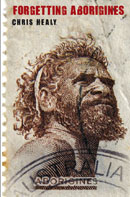review by Maria Nugent

Forgetting Aborigines is the much anticipated second monograph by historian and cultural studies scholar Chris Healy. It comes a decade or so after his important book From the Ruins of Colonialism: History as Social Memory. Readers of reCollections might well be familiar with the latter because of its discussion about the role of museums (along with schools) as key sites of social memory.
In Forgetting Aborigines, Healy continues to pursue his interest in the 'ways in which the past is recalled and made present' (p. 8). The emphasis in From the Ruins was the past socially and collectively remembered; the argument that sustains this new book is that cultural memory cannot be understood adequately without a careful consideration of practices and patterns of forgetting. In the introduction, Healy explains:It's important to insist that Forgetting Aborigines is attempting to think about both remembering and forgetting, because there is never one without the other. At the most basic level, the selective recognition of some things rather than others, and the discerning organisation of those elements so that they can be made present, requires forgetting. (p. 9)
In this respect, Healy follows the direction that the scholarly field of memory studies has taken over the last decade at least.
Aborigines or, more precisely, Aboriginality, is the book's subject. Borrowing from Marcia Langton's seminal essay, 'Well, I Heard it on the Radio and I Saw it on the Television ', Healy is concerned with what Langton glossed as the 'intercultural space of Aboriginality'. This refers to the way ideas about Aborigines and Aboriginality are culturally and textually produced, with little or no reference to the actual life experiences of Aboriginal people. Popular perceptions about Aborigines, Langton memorably argued, are founded upon stories inherited from colonists and are nourished by accrued misrepresentations. Healy revisits this intercultural space in order to explore the dynamics of remembering and forgetting that work to 'produce indigenous and non-indigenous people in relation to each other' (pp. 4–5), with a focus on the period from the 1950s onwards. By taking this approach, Healy has moved some distance away from the oppositional structure of his discussion about Aboriginal and non-Aboriginal forms of social memory and historical consciousness in From the Ruins of Colonialism, in which he contrasted 'white' with 'black' histories of Captain Cook. This time around, he is interested in conceptualising and accounting for the entanglements between Aboriginal and non-Aboriginal people, both in the colonial past and in respect to (postcolonial) modes of remembering that past in the present.
The book consists of five essays. After an introduction to the main concepts, arguments and themes, there are chapters on television, art, heritage, museums, and tourism, all key public sites for the cultural production of Aboriginality. Often robust in their arguments, at times provocative, and occasionally confronting, the chapters are all models of interpreting the fluid patterning of cultural memory, an intellectual task which in my view is more demanding than simply exposing and dismissing 'bad' (or 'rubbish') representations. For instance, in his chapter on television, Healy considers the series Alcheringa, made by the Australian Broadcasting Commission in 1962. While he admits it 'produces "bad" representations of indigenous people' (p.37), particularly in terms of its deployment of primitivist stereotypes, he seeks to go beyond that assessment to consider the program's place within a broad and variegated history of televisual and other popular portrayals of Aboriginality within public culture. Importantly, he restores to the discussion some appreciation of the complexities of the cross-cultural exchanges behind the show's production, and in its content and engagement with its audience. This approach extends to his discussion of objects and their display within museums. His case study is Aboriginal breastplates. Not satisfied with interpreting them singularly as the detritus of colonial conquest, Healy instead treats them as 'cross-cultural objects wrought out of the ambivalences of colonial encounters'. An emphasis on what he calls their transactional histories allows a rich range of possibilities for interpreting them, which opens up rather than closes down their meanings.
Throughout the book, as he moves from site to site, or as he considers his examples from various vantage points, Healy is pointing the reader towards an appreciation of the ways in which public remembrances of Aboriginality necessarily involves forgetting real people, actual encounters, and messy and ambivalent histories. In the end, Healy, unlike many other scholars and commentators, is not advocating as redress more and improved forms of remembering the past in the present. Indeed, he argues that what is perhaps more, or equally, pressing is that we better remember past habits of forgetfulness; or, to put it another way, that we stop forgetting our own forgetting. By that means, he repeatedly suggests, we might engage more directly with our entangled histories.
Forgetting Aborigines is not always an easy read. In some parts, it seems as though the author is in conversation with just a handful of peers. And it's quite narrowly Australian in focus, which probably means that it will not get an international readership. That's a pity. Nonetheless, it is a timely book on an important intellectual project, and one that should stimulate further studies in the field. There is much more to learn about Australian cultures of memory in respect to Aboriginality. This book provides a model for thinking about these difficult issues as well as intellectual inspiration for future inquiry.
Maria Nugent is research fellow in the Centre for Historical Research, National Museum of Australia.
